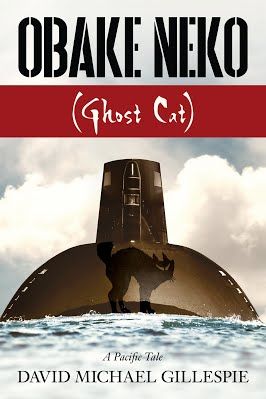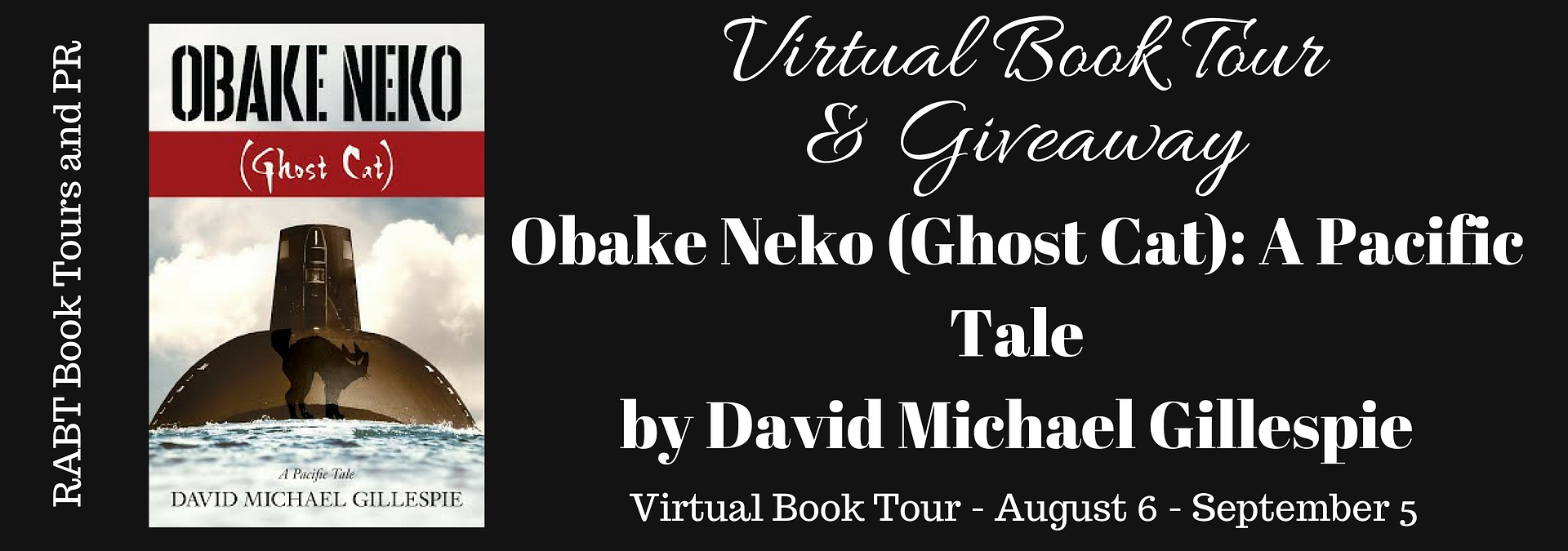Don't miss the Rafflecopter giveaway at the end of this post!

Mystery/Historical Fiction
Date Published: May 31, 2018
It begins with a disappearance… In the waning days of World War II, the Obake Neko is the last surviving Sen-Toku—a huge secret aircraft-carrier submarine created by the Imperial Japanese Navy. As the war comes to an end, the Obake Neko sets sail back to Japan with a cargo of unimaginable value. In the chaos of Japanese surrender, the clandestine vessel and its crew vanish in the seas of the South Pacific.
Fifty-five years after the war’s end, former U.S. Navy pilot, Bud Brennan breaks into Pearl Harbor’s submarine museum in Hawaii. Bud’s son, Mike, is still raw from the death of his wife and grappling with a new career but still jumps in to help his dad. But when Bud’s antics garner the attention of the Navy’s JAG, Mike realizes his father may possess knowledge about the near-mythical Obake Neko and its fabled cargo—knowledge that is also of great value to the Japanese Yakuza. Now, Mike must scramble to learn the whole truth of his father’s decades-old connection with the legendary Japanese submarine and fight to defend his father from relentless military authorities and deadly Yakuza operatives. Even decades later, the Obake Neko and its legendary cargo are still worth killing over.
Can Mike discover the truth and protect his dad before deadly assailants succeed in silencing Bud forever?
August 27, 1945
A steady, gentle breeze nudged Lieutenant Bud Brennan’s life raft over the calm South Pacific Ocean. He dipped his left hand into the water and swished it around, then pulled it out. The water and air were in perfect harmony—only a few degrees difference between the two. He looked up at the faint horizon. A half-moon hung low in the night sky, making the sea sparkle and shimmer.
Bud leaned back and relaxed as the light wind pushed him and the three others inside their four-man life raft. It was so quiet. Bud drifted off to sleep before a loud ‘CLANG’ startled him. The harsh metal-on-metal noise brought him to full alert and yanked him into the real world.
Four days before, on a flight from New Guinea to Guam, ferrying a B-24 Liberator with a last-minute skeleton crew, Bud and three airmen had experienced engine trouble. Halfway to Guam, the bomber lost the outside starboard engine and, within minutes, the inside engine on the same wing sounded rough and ready to fail. The plane had shaken like a wet dog out of a bath, and thick, dark-brown oil sprayed on the front windshield from a busted outside lubricant line. Bud had struggled to prevent the heavy bomber from corkscrewing. There was no way he could have held the plane aloft. Suddenly, flames had engulfed the failing inside engine.
He’d swiveled to the tail and yelled at the crew to jump; they were already prepared for the worst. After everyone had bailed, he’d opened the bomb bay doors, cut off the fuel to all engines, leveled off, and tried to glide. He’d gingerly let go of the yoke and raced along the plane’s narrow walkway to the bomb bay doors and dived into the open hatch. He barely cleared the bomber as it nosed over and exploded in a giant fireball.
Bud’s parachute opened with no trouble, but he had lost a lot of altitude trying to keep the huge plane flying. A full moon showed him he floated low, but not too low for a safe ditching. The ocean’s condition concerned him, but as he strained his eyesight, he glimpsed calm seas. After plunging into the ocean, he released his chute. His Mae West life preserver was intact and took only seconds to inflate. Bud was relieved to find one of the crew had grabbed an A-3 life raft as they’d bailed out, and within half an hour, everyone was on board. Unfortunately, the radioman’s parachute had malfunctioned, and he had hit the water hard. He became hysterical as the night wore on and slipped in and out of consciousness.
For four days they drifted at sea without spotting a plane or a ship that might offer salvation. By the second day, Bud had major concerns about his crew members. They had used up the eight eleven-ounce cans of water and the few food bars they had. With the war over, things had become slack, and no one had checked the emergency supplies before they took off. They were lucky to have a raft.
Two hours before dawn on the fifth day, Bud studied his sleeping crew with his flashlight and worried about how much longer they could last. On average, they were only four years younger than he was, but none had any combat experience. Nothing to harden them to the reality of war. He’d been through a similar ordeal, ditching two years ago after his Hellcat fighter ran out of fuel ten miles from his base aircraft carrier. Bud had spent three days floating alone before being rescued by a US destroyer.
“Look, guys, we’ve got to keep our spirits up. That’s half the battle. If we can hang in there, something will turn up.” Bud turned to his copilot and pointed at him. “Jimmy, let’s start with you. What are you looking to do when we get out of this mess?”
“I just want to survive, that’s all.” Jimmy coughed. “Leave me alone, okay?”
Bud took a deep breath; he wasn’t giving up so easily. For him, to make it through all he’d endured during the past four years of war and then fail so close to getting home was not acceptable. He knew what he wanted and would not let it slip away. He must survive, must.
“Okay, I’ll go first.” Bud thumped his chest once. “Once I’m stateside, I’m heading home and marrying a girl that’s waited for me for four long years.” He smiled at the picture in his head of a quiet beauty with thick auburn hair.
“Then I’m going to use my GI Bill and earn an electrical engineering degree at a good school. With my diploma, I’ll get a job at the Pennsylvania Power and Light Company and eventually buy a house and enjoy life.”
His family roots were stuck in the coal mines, and he would do anything not to follow that path. He’d taken advantage of any opportunities offered as he grew up poor in rural Pennsylvania. In early 1941, after the Civil Air Patrol office at the small airport near his house had announced free flying lessons for five qualified students, he’d slept out in front of their office the night before the registration day to make sure he was first in line.
“What, not planning on any kids?” Jimmy asked.
“Well, yeah, I guess so, but they’re not my priority.” Bud shrugged his shoulders. “If the wife insists, I’ll go along.”
Jimmy coughed again. “Christ, with that attitude I’d hate to be your kid.”
Bud blinked and stared at him. He really hadn’t thought about children.
“Oh yeah, also, I’m going to get back to Hawaii one day. I only spent two months there for training, but I’m crazy about that place and the people, and I’m sick of the cold, snow, and month after month of gray overcast winter skies in Pennsylvania.”
Bud had used his free time during training to enjoy the beaches in rural Oahu, not on Waikiki Beach. He’d met and made friends with families living near the shore. They’d treated him like a long-lost relative, feeding him and providing a tent for him to sleep on the sand at night.
“I’m going there to live, not just to visit. Even if it’s in retirement. I really love that place, and the people.” He nodded his head several times. “Yeah, I’ll get back, someday.”
No one said anything; no one cared about anything except survival. They all drifted in and out of sleep.
Near daybreak, everyone except Bud still slept. The sun would rise in less than an hour. He brushed back his curly, jet-black hair and gazed up at the half-moon floating overhead. There were calm winds, but the wave action had picked up, and the sea was slushy.
Now, to figure out if that damn clang was just part of a dream, he thought.
From his seated position, arms spread out wide over the raft’s edge, he twisted around. Halfway through his turn, he knelt in the raft and gasped as he faced a monstrous object sitting low in the water about a hundred feet away. A ship, dead in the water; its black, bulky shape smelling of dirty oil. All at once, diesel engines rumbled from deep inside the sinister-looking vessel. A moment later a crane slowly rose like a ghost over a graveyard, midway between the bow end and the boat’s middle.
Although his pilot training included friendly and enemy ship profile classes, this boat fit none of the classifications he recalled.
Friend or enemy? The war had ended twelve days before, and the Japanese had officially surrendered, but maybe not every vessel had received the news, and a few may have decided not to yield without a fight. Bud had heard horror stories of atrocities inflicted on captured Allied sailors. He glanced behind him for a second and checked the inside of the raft. The three crew members were out, lying lifeless in the bottom and oblivious to the enormous ship nearby.
As he inspected the vessel, silhouettes of men scurried about the boat. They appeared to be scrambling to prepare for some event. What he assumed was a submarine’s conning tower sat in the middle of the boat. But if it was a sub, it stretched nearly two times longer than any he’d ever seen. Oddly, there was a massive tube structure connected to the sail, and that made no sense. The centered tube stretched one-quarter the length of the sub, about a hundred feet, and appeared around ten feet in diameter.
Bud observed several crew members open a huge, cone-shaped hatch on the bow end of the tube and shove out a box that looked like an oversized coffin. The crane swung over and picked it up, carried it to the sub’s edge, and dumped it into the ocean. They repeated this maneuver ten times. As the crane cast off the tenth box, it struck the boat’s hull at the water line. Someone yelled in Japanese. The timbre of the voice startled Bud. A sound of authority, but more, a gravel texture—an unnatural roughness. He quickly snapped out of his fixation on the voice. This was not a friendly ship.
After a few minutes, the giant circular door slowly closed over the tube, the crane folded into the deck, and the diesel engines became silent. Within seconds, everyone but two or three men on the conning tower disappeared. Lights flashed on and off, briefly saturating the side of the sail in an intense white light. The gravel voice hurled curses into the night. Before the lights blinked out, Bud spotted a caricature painted on the conning tower’s side. An image of a startled black cat in profile, fur and tail straight up, back arched high, framed in white, looking sideways. Its white, menacing eyes burrowing right into him.
“No, no, no!” the radioman screamed and thrashed in the bottom of the raft. Bud jerked back and fell on him, smothering his mouth with both hands. The other two crew members woke and stared at him but didn’t sit up. Bud crouched and swiveled around to face the sub, eyes wide open, and peeked over the raft’s edge. High on the sail’s tower someone shouted, and a searchlight switched on. The bright penetrating light swept the ocean, zigzagging back and forth the length of the boat, extending its piercing reach with each swing. Bud’s eyes fixed on the beam as it drew closer and closer. Its intense ray blinded him for a second and moved on. Abruptly it returned and locked on him, flooding their raft with its powerful, harsh glare.
About the Author
David Gillespie moved to Hawaii as a teenager, where he attended public schools and graduated with a BBA and MBA from the University of Hawaii at Manoa.
Gillespie has had a varied career in Hawaii’s business community. As a consultant with a University of Hawaii program, he traveled to many Pacific Island nations. His experiences in these exotic locales, along with his keen interest and research about the Sen-Toku Japanese submarines, inform and enhance his writing.
Gillespie is retired and has taken up home improvement projects, earned a private pilot license, and works on writing historical adventure novels. He continues to enjoy life in Hawaii, his home, with his family and a tuxedo cat named Tick Tock.
Contact Link
Purchase Link



1 comment:
thank you for posting
Post a Comment